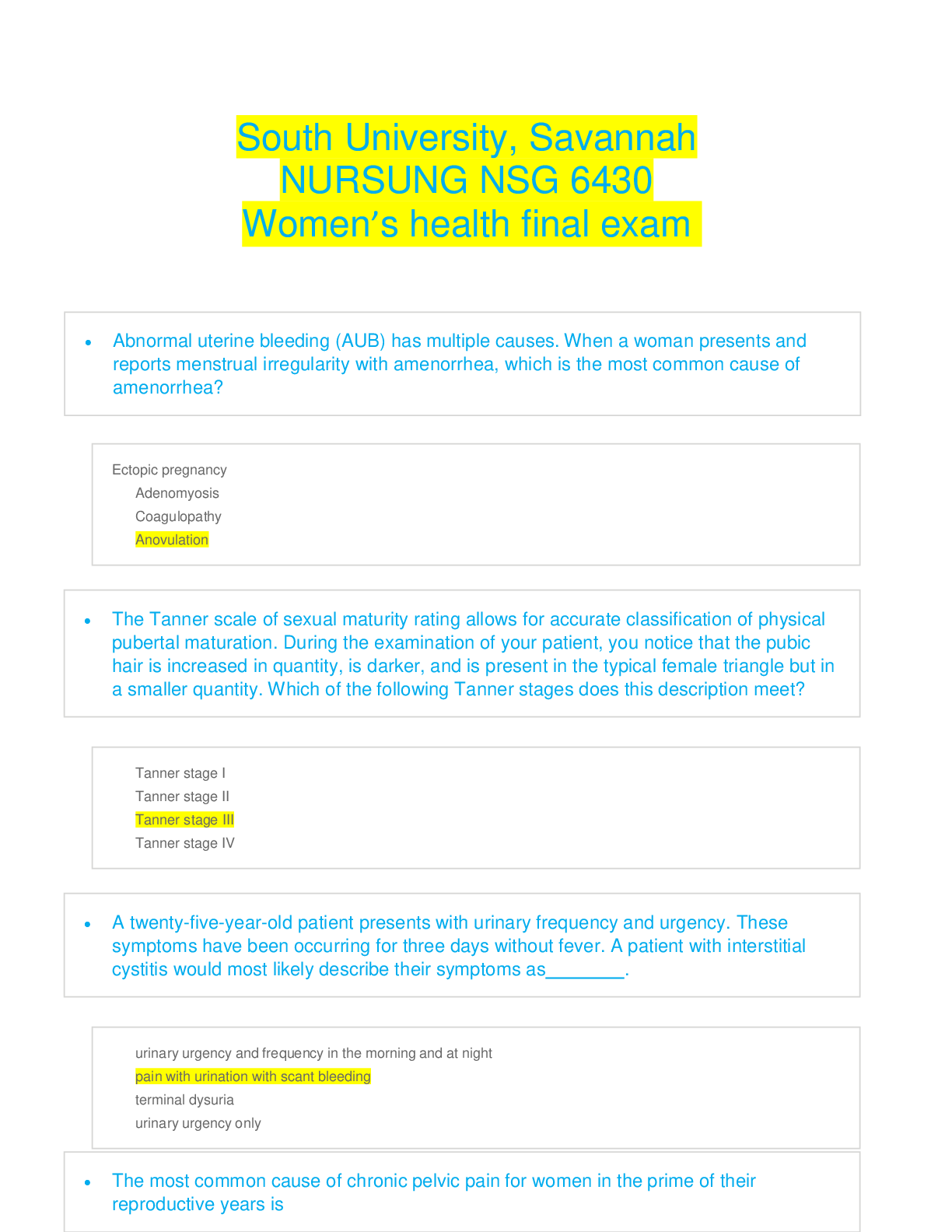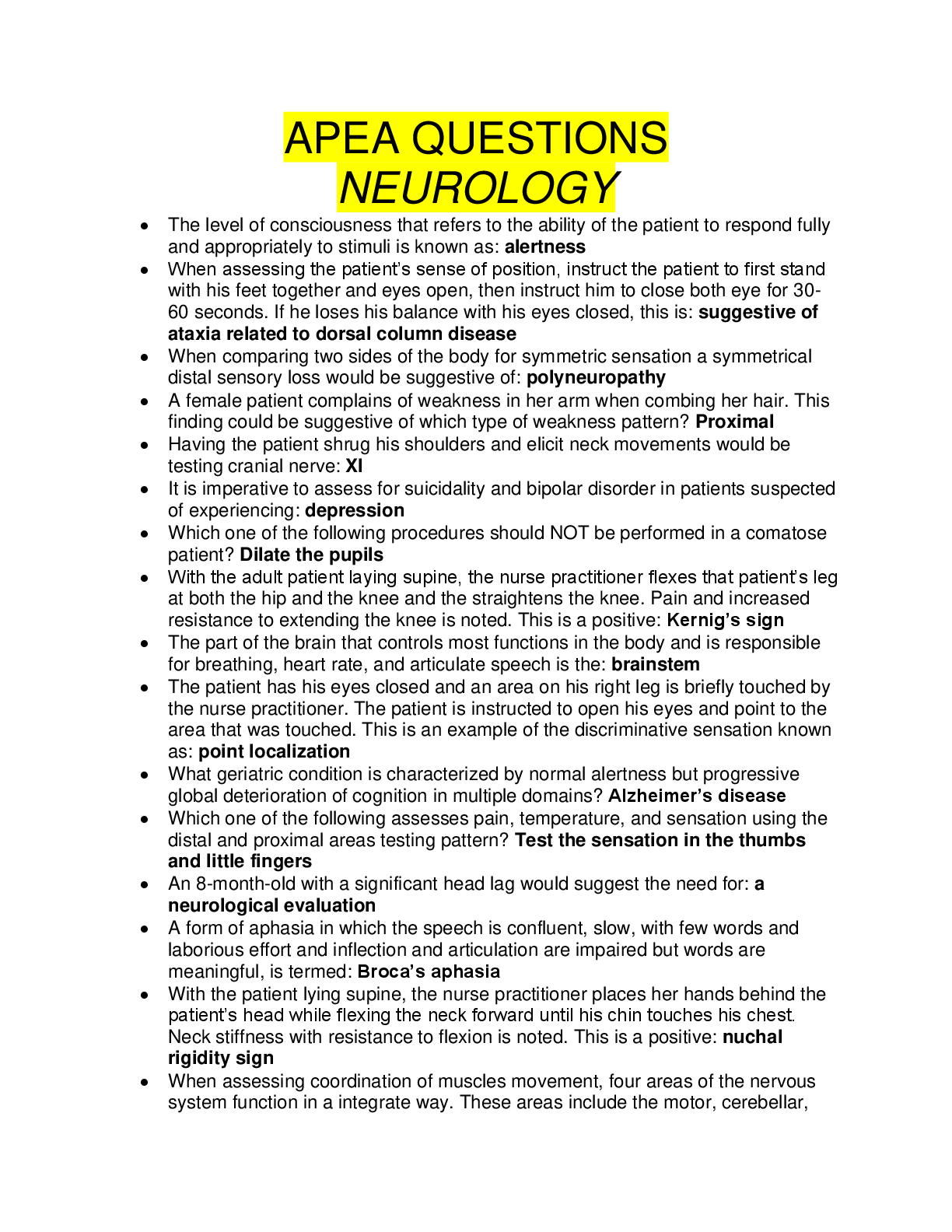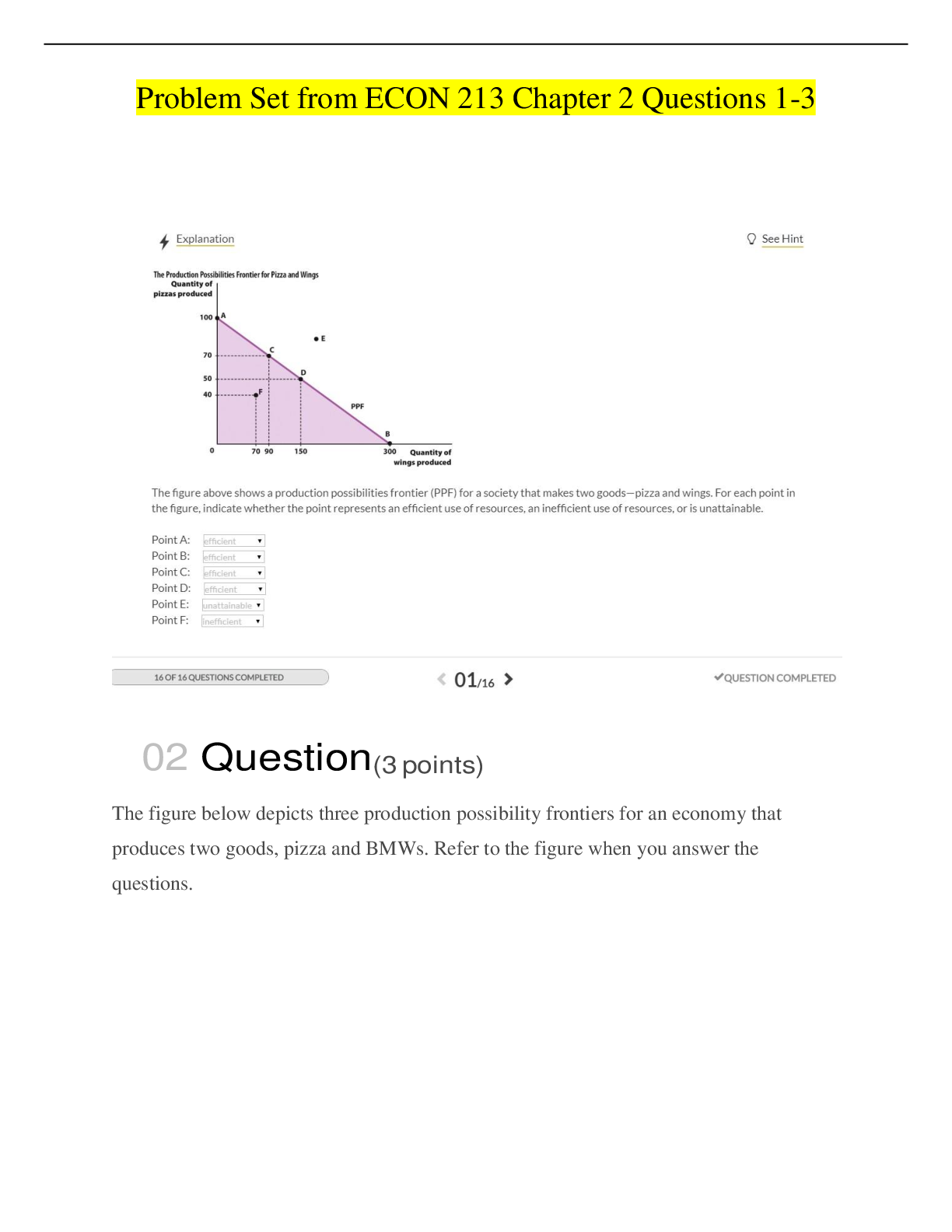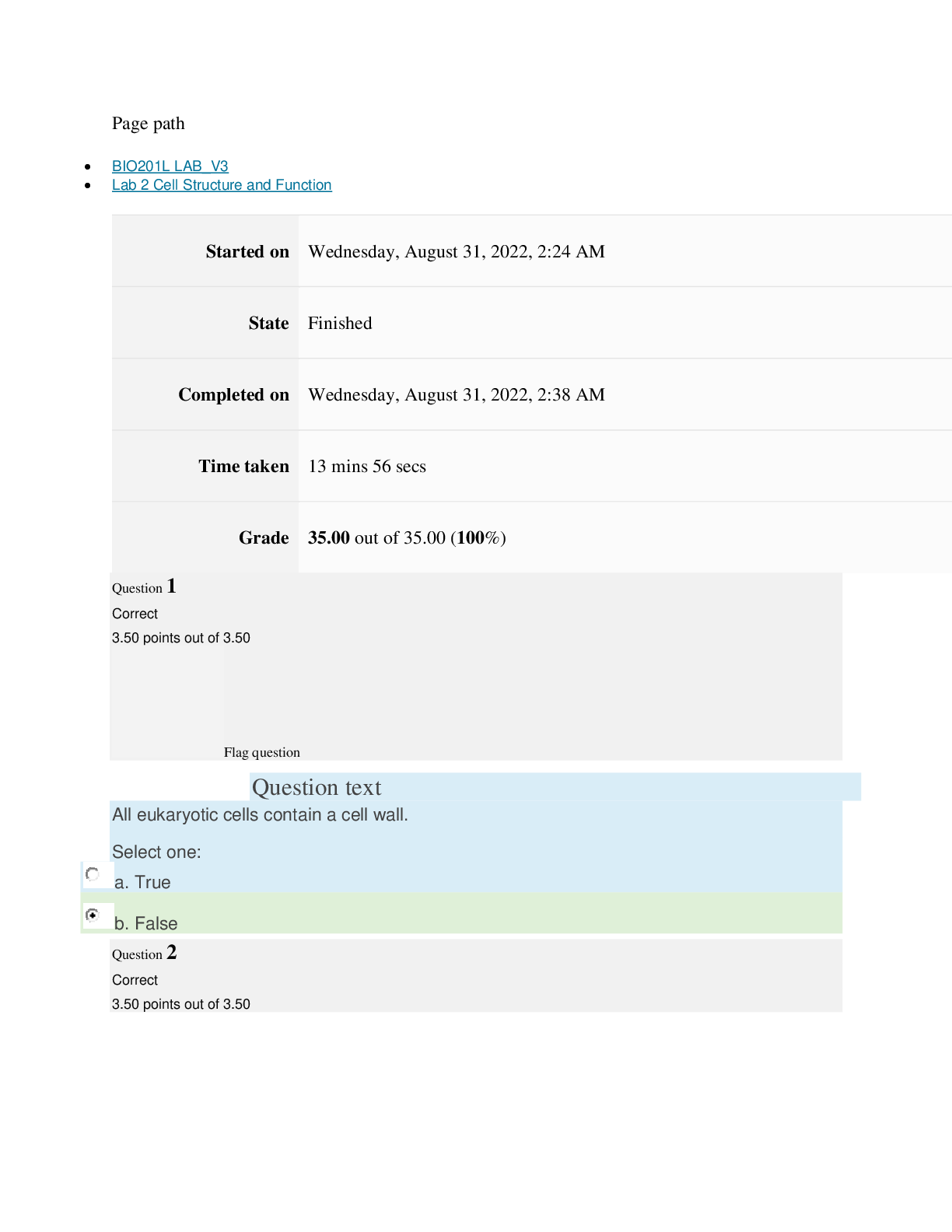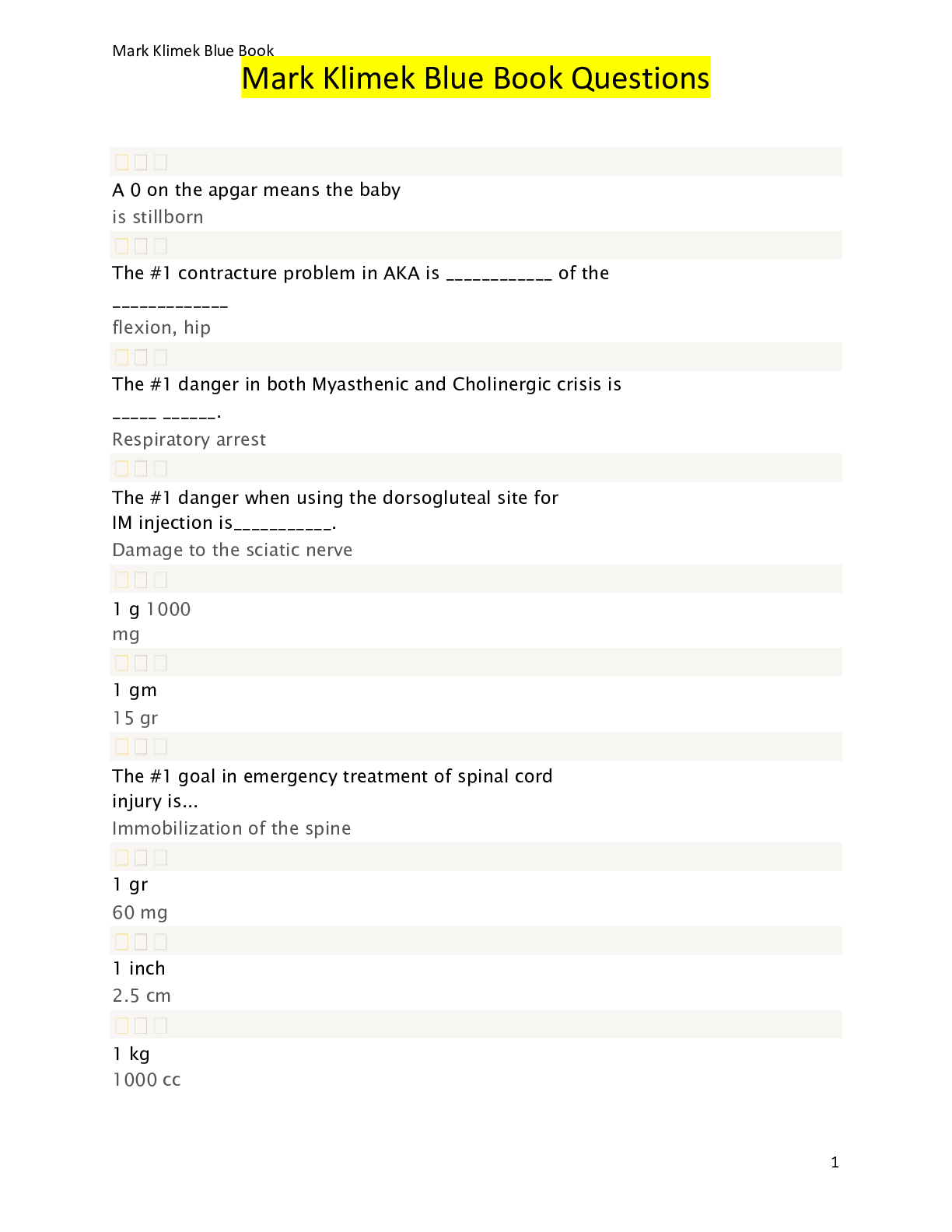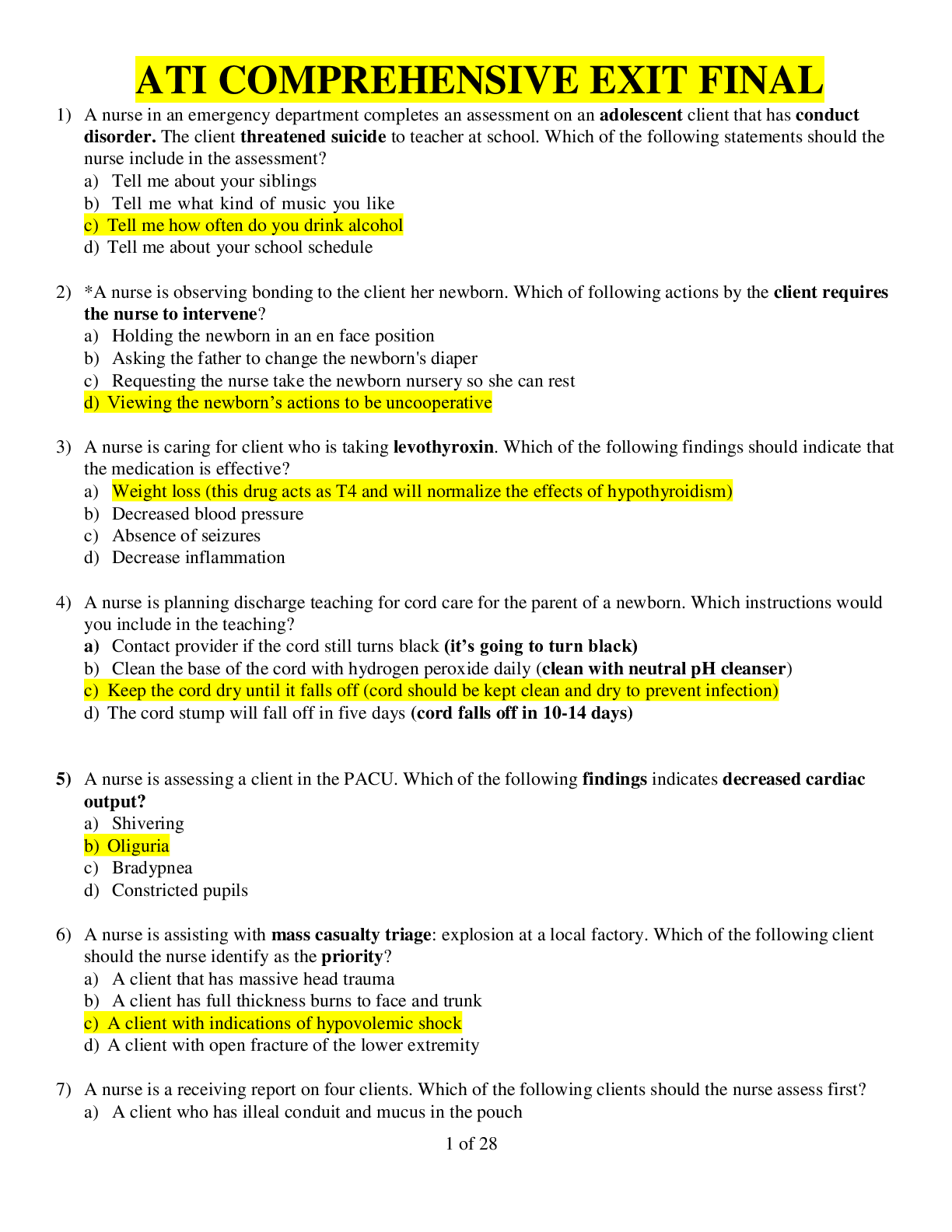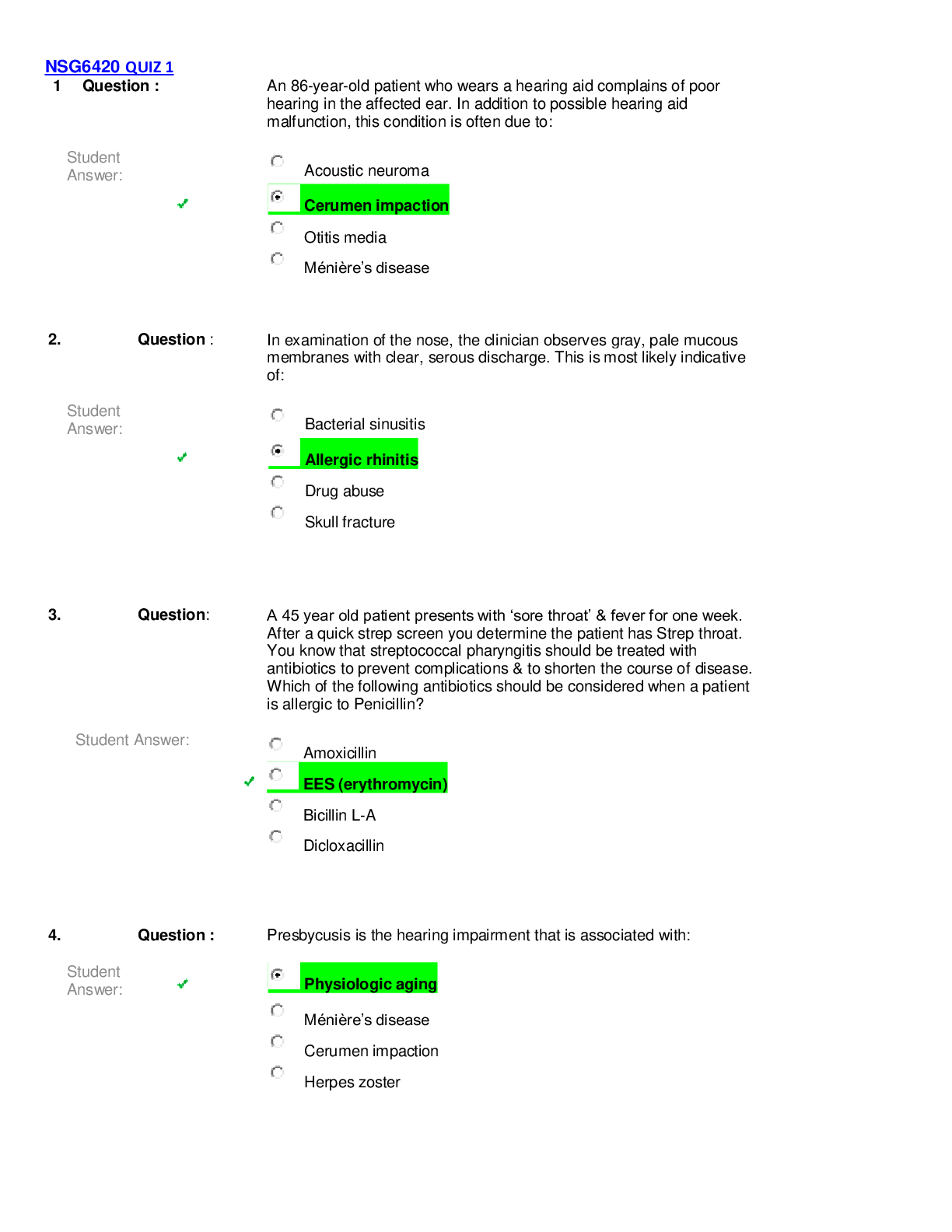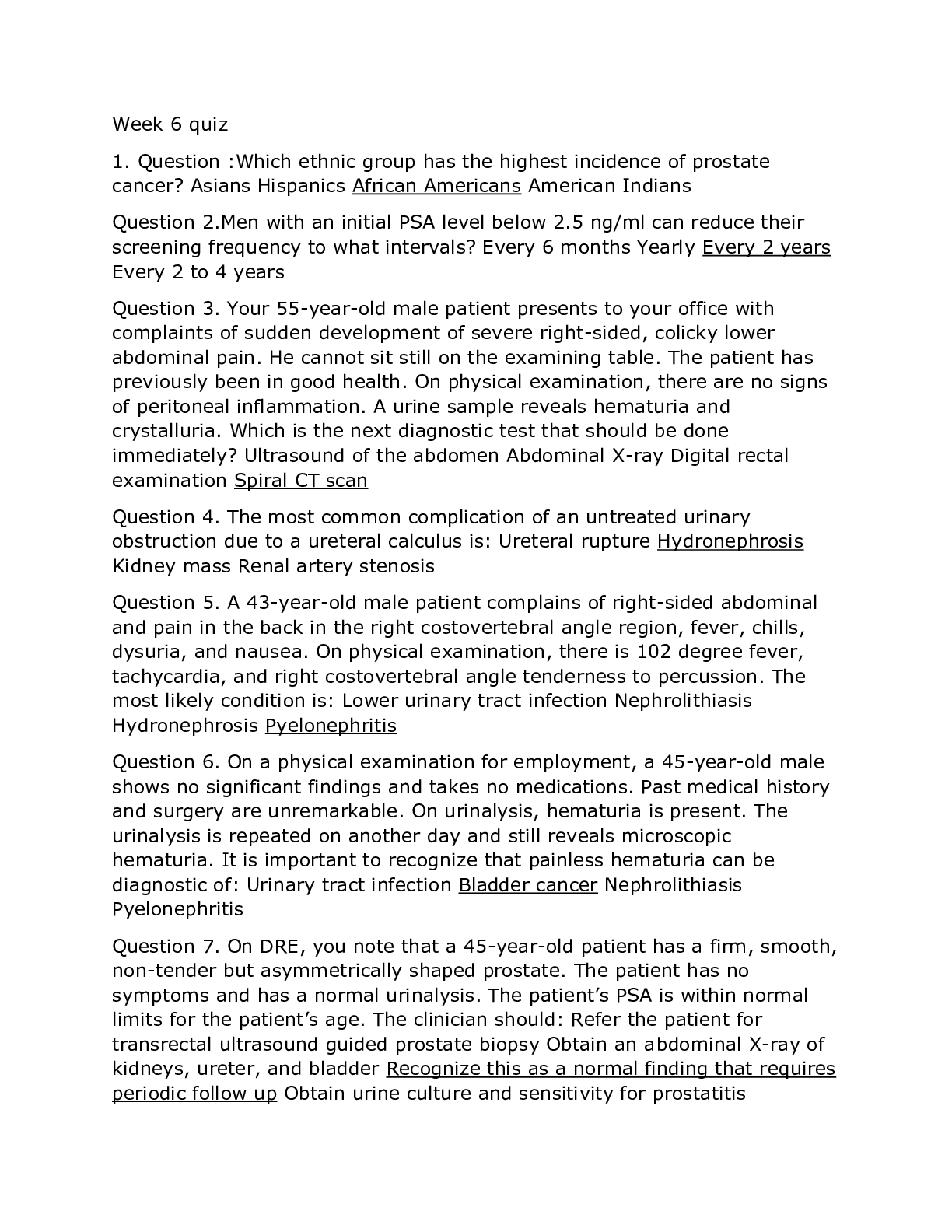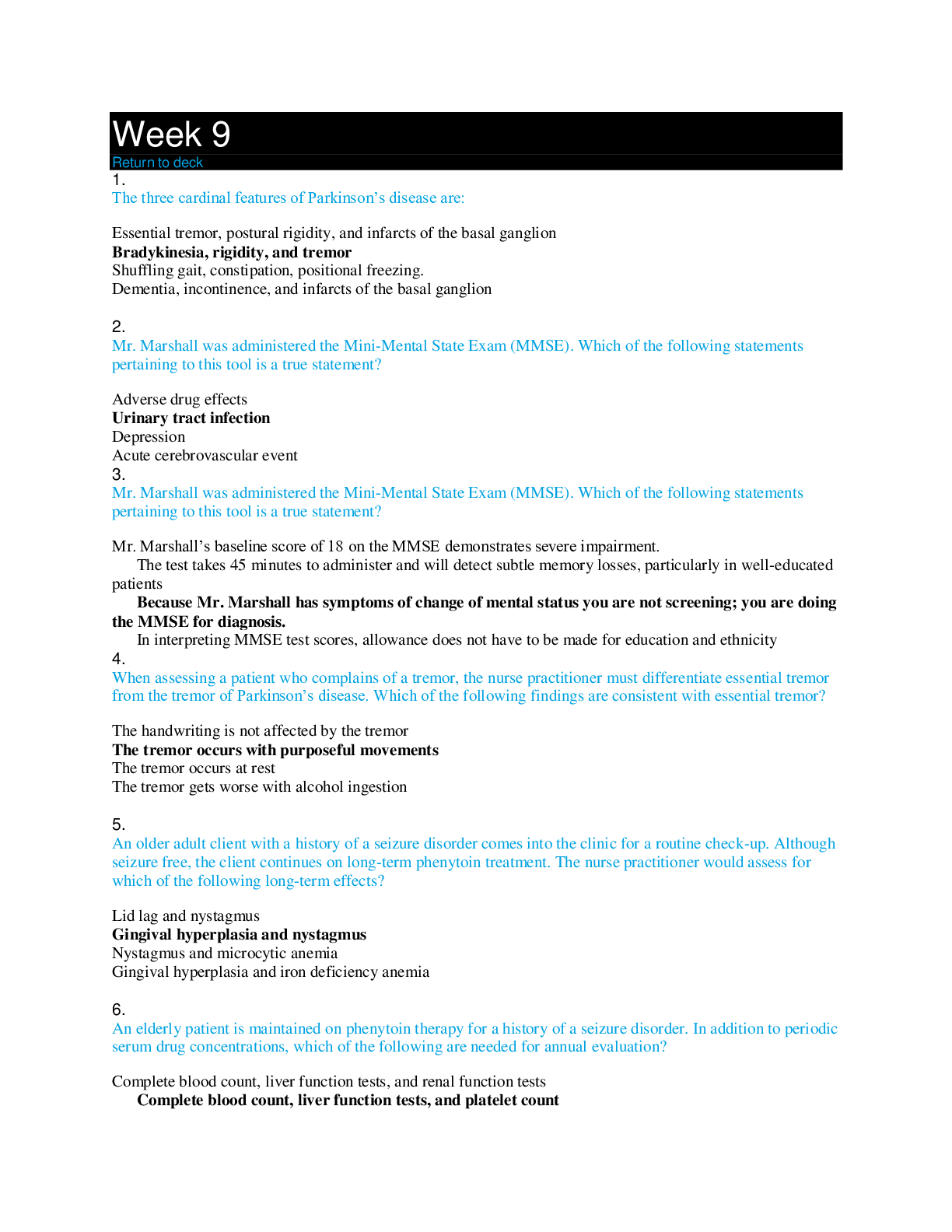*NURSING > QUESTIONS & ANSWERS > South University NSG 6420 Week 5 Quiz / South University NSG6420 Week 5 Quiz (2020, Latest) (Already (All)
South University NSG 6420 Week 5 Quiz / South University NSG6420 Week 5 Quiz (2020, Latest) (Already graded A)
Document Content and Description Below
Week 5 Mid-term Return to deck 1. A 22-year-old female comes to your office with complaints of right lower quadrant abdominal pain, which has been worsening over the last 24 hours. On examination o... f the abdomen, there is a palpable mass and rebound tenderness over the right lower quadrant. The clinician should recognize the importance of Digital rectal examination Endoscopy Pelvic examination UrinalysisDefinition 2. Which of the following clinical reasoning tools is defined as evidence-based resource based on mathematical modeling to express the likelihood of a condition in select situations, settings, and/or patients? Clinical practice guideline Clinical decision rule Clinical algorithm Clinical recommendation 3. A common auscultatory finding in advanced CHF is S3 gallop rhythm 4. Mr. Keenan is a 42-year-old man with a mild history of GERD and a remote history of an appendectomy, presenting with an acute onset of significant right upper-quadrant abdominal pain and vomiting. His pain began after a large meal, was unrelieved by a proton-pump inhibitor, was unlike his previous episodes of heartburn, but upon questioning, reports milder, prodromal episodes of similar post-prandial pain. His pain seems to radiate to his back. Despite a family history of cardiac disease, he reports no classic anginal signs or chest pain. He furthermore denies respiratory or pleuritic signs and denies fever, night sweats, and unintended weight loss. Finally, there are no dermatologic signs, nor genitourinary symptoms. The chosen imaging study reveals: “GB normal in size without wall-thickening, but with 5-6 stones with shadowing. Common bile duct not dilated. Liver is homogenous and normal in size. Pancreas and kidneys are normal.” What is the most effective therapeutic/management option at this point? chole 5. A patient complains of fever, fatigue, and pharyngitis. On physical examination there is pronounced cervical lymphadenopathy. Which of the following diagnostic tests should be considered? Mono spot Strep test Throat culture All of the above 6. Which of the following is not a contributing factor to the development of esophagitis in older adults? 7. Essential parts of a health history include all of the following except: 8. What test is used to confirm the diagnosis of appendicitis? 9. The first assessment to complete related to the eyes is Eye lids Visual acuity Extraocular movements Peripheral vision 10. The best way to diagnose structural heart disease/dysfunction non-invasively is Chest X-ray EKG CORRECT Echocardiogram Heart catheterization 11. Which of the following is considered a “red flag” when diagnosing a patient with pneumonia Fever of 102 Infiltrates on chest X-ray Pleural effusion on chest X-ray Elevated white blood cell count 12. In a patient presenting with suspected recurrence of diverticulitis, abdominal pain usually presents where in the abdomen? Left upper quadrant Right upper quadrant Left lower quadrant Right lower quadrant 13. Mr. A presents to your office complaining of chest pain, mid-sternal and radiating to his back. He was mowing his lawn. He reports the pain lasting for about 8 minutes and went away after sitting down. What is his most likely diagnosis based on his presenting symptoms Acute MI GERD Pneumonia Angina 14. In autosomal recessive (AR) disorders, individuals need Only one mutated gene on the sex chromosomes to acquire the disease Only one mutated gene to acquire the disease Two mutated genes to acquire the disease Two mutated genes to become carriers 15. Susan P., a 60-year-old woman with a 30 pack year history, presents to your primary care practice for evaluation of a persistent, daily cough with increased sputum production, worse in the morning, occurring over the past three months. She tells you, “I have the same thing, year after year.” Which of the following choices would you consider strongly in your critical thinking process? chronic bronichitis 16. The best evidence rating drugs to consider in a post myocardial infarction patient include: ASA, ACE/ARB, beta-blocker, aldosterone blockade ACE, ARB, Calcium channel blocker, ASA Long-acting nitrates, warfarin, ACE, and ARB ASA, clopidogrel, nitrates 17. A 76-year-old patient with a 200-pack year smoking history presents with complaints of chronic cough, dyspnea, fatigue, hemoptysis, and weight loss over the past 2 months. The physical exam reveals decreased breath sounds and dullness to percussion over the left lower lung field. The chest X-ray demonstrates shift of the mediastinum and trachea to the left. These are classic signs of: Lung cancer Tuberculosis Pneumonia COPD 18. Upon assessment of respiratory excursion, the clinician notes asymmetric expansion of the chest. One side expands greater than the other. This could be due to Pneumothorax Pleural effusion Pneumonia Pulmonary embolism 19. A patient presents with eye redness, scant discharge, and a gritty sensation. Your examination reveals the palpable preauricular nodes, which are most likely with: Bacterial conjunctivitis B. Allergic conjunctivitis C. Chemical conjunctivitis D. Viral conjunctivitis 20. Emphysematous changes in the lungs produce the following characteristic in COPD patients? Asymmetric chest expansion Increased lateral diameter Increased anterior-posterior diameter Pectus excavatum 21. An older patient reports burning pain after ingestion of many foods and large meals. What assessment would assist the nurse practitioner in making a diagnosis of GERD? A. Identification of a fluid wave B. Positive Murphy’s sign C. Palpable spleen D. Midepigastric pain that is not reproducible with palpation 22. Which of the following details are NOT considered while staging asthma? A. Nighttime awakenings B. Long-acting beta agonist usage C. Frequency of symptoms D. Spirometry findings 23. The cytochrome p system involves enzymes that are generally Inhibited by drugs : • Inhibited by drugs • Induced by drugs • Inhibited or induced by drugs • Associated with decreased liver perfusion 24. Mr. Keenan is a 42-year-old man with a mild history of GERD and a remote history of an appendectomy, presenting with an acute onset of significant right upper-quadrant abdominal pain and vomiting. His pain began after a large meal, was unrelieved by a proton-pump inhibitor, was unlike his previous episodes of heartburn, but upon questioning, reports milder, prodromal episodes of similar post-prandial pain. His pain seems to radiate to his back. Despite a family history of cardiac disease, he reports no classic anginal signs or chest pain. He furthermore denies respiratory or pleuritic signs and denies fever, night sweats, and unintended weight loss. Finally, there are no dermatologic signs, nor genitourinary symptoms. Of the following lab studies, which would provide little help in determining your differential diagnosis? Abdominal plain films Liver function tests Amylase/lipase Urinalysis 25. Jeff, 48 years old, presents to the clinic complaining of fleeting chest pain, fatigue, palpitations, lightheadedness, and shortness of breath. The pain comes and goes and is not associated with activity or exertion. Food does not exacerbate or relieve the pain. The pain is usually located under the left nipple. Jeff is concerned because his father has cardiac disease and underwent a CABG at age 65. The ANP examines Jeff and hears a mid-systolic click at the 4th ICS mid-clavicular area. The ANP knows that this is a hallmark sign of: Angina Pericarditis Mitral valve prolapse Congestive heart failur 26. Men have faster and more efficient biotransformation of drugs and this is thought to be due to: • Less obesity rates than women • Prostate enlargement • Testosterone • Less estrogen than women 27. An 82-year-old female presents to the emergency department with epigastric pain and weakness. She admits to having dark, tarry stools for the last few days. She reports a long history of pain due to osteoarthritis. She self-medicates daily with ibuprofen, naprosyn, and aspirin for joint pain. On physical examination, she has orthostatic hypotension and pallor. Fecal occult blood test is positive. A likely etiology of the patient’s problem is: Mallory-Weiss tear B. Esophageal varices C. Gastric ulcer D. Colon cancer 28. You have a patient complaining of vertigo and want to know what could be the cause. Knowing there are many causes for vertigo, you question the length of time the sensation lasts. She tells you several hours to days and is accompanied by tinnitus and hearing loss. You suspect which of the following conditions? Ménière’s disease Benign paroxysmal positional vertigo Transient ischemic attack (TIA) MigraineDefinition 29. . Your patient has been treated for glaucoma for 5 years. Which of the following will provide indication of the level of progression during the funduscopic examination for this patient? Checking the macula Estimating cup-to-disk ratio Verifying a red reflex Extraocular movements 30. If it has been determined a patient has esophageal reflux, you should tell them: They probably have a hiatal hernia causing reflux They probably need surgery They should avoid all fruit juices Smoking, alcohol, and caffeine can aggravate their problem 31. The following criterion is considered a positive finding when determining whether a patient with asthma can be safely monitored and treated at home: Age over 40 Fever greater than 101 Tachypnea greater than 30 breaths/minute Productive cough 32. Jenny is a 24 year old graduate student that presents to the clinic today with complaints of fever, midsternal chest pain and generalized fatigue for the past two days. She denies any cough or sputum production. She states that when she takes Ibuprofen and rest that the chest pain does seem to ease off. Upon examination the patient presents looking very ill. She is leaning forward and states that this is the most comfortable position for her. Temp is 102. BP= 100/70. Heart rate is 120/min and regular. Upon auscultation a friction rub is audible. Her lung sounds are clear. With these presenting symptoms your initial diagnosis would be Mitral Valve Prolapse Referred Pain from Cholecystitis Pericarditis Pulmonary Embolus 33. During auscultation of the chest, your exam reveals a loud grating sound at the lower anterolateral lung fields, at full inspiration and early expiration. This finding is consistent with: Pneumonia Pleuritis Pneumothorax CORRECT A and B 34. Your 35-year-old female patient complains of feeling palpitations on occasion. The clinician should recognize that palpitations are often a sign of Anemia Anxiety Hyperthyroidism CORRECT All of the above 35. Presbycusis is the hearing impairment that is associated with: Physiologic aging Ménière’s disease Cerumen impaction Herpes zoster 36. Functional abilities are best assessed by : • Self-report of function • Observed assessment of function • A comprehensive head-to-toe examination • Family report of function 37. In examining the mouth of an older adult with a history of smoking, the nurse practitioner finds a suspicious oral lesion. The patient has been referred for a biopsy to be sent for pathology. Which is the most common oral precancerous lesion? Fictional keratosis Keratoacanthoma Lichen planus Leukoplakia 38. The aging process causes what normal physiological changes in the heart? The heart valve thickens and becomes rigid, secondary to fibrosis and sclerosis Cardiology occurs along with prolapse of the mitral valve and regurgitation Dilation of the right ventricle occurs with sclerosis of pulmonic and tricuspid valves Hypertrophy of the right ventricle 39. In assessing the eyes, which of the following is considered a “red flag” finding when associated with eye redness? History of prior red-eye episodes Grossly visible corneal defect Exophthalmos Photophobia 40. Helicobacter pylori is implicated as a causative agent in the development of duodenal or gastric ulcers. What teaching should the nurse practitioner plan for a patient who has a positive Helicobacter pylori test? A. It is highly contagious and a mask should be worn at home. B. Treatment regimen is multiple lifetime medications. C. Treatment regimen is multiple medications taken daily for a few weeks. D. Treatment regimen is complicated and is not indicated unless the patient is symptomatic. [Show More]
Last updated: 2 years ago
Preview 1 out of 6 pages

Buy this document to get the full access instantly
Instant Download Access after purchase
Buy NowInstant download
We Accept:

Reviews( 0 )
$5.00
Can't find what you want? Try our AI powered Search
Document information
Connected school, study & course
About the document
Uploaded On
Apr 09, 2020
Number of pages
6
Written in
Additional information
This document has been written for:
Uploaded
Apr 09, 2020
Downloads
0
Views
99

